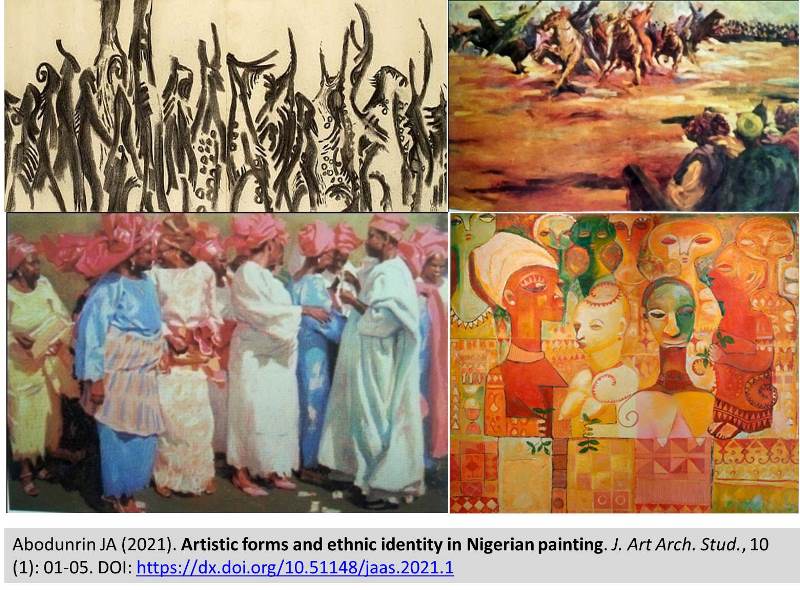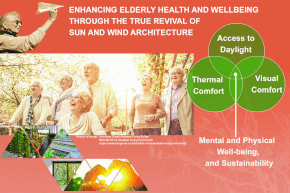Previous issue | Next issue | Archive
![]() Volume 10 (1); June 15, 2021 [Booklet]
Volume 10 (1); June 15, 2021 [Booklet]
Artistic forms and ethnic identity in Nigerian painting
Abodunrin JA.
J. Art Arch. Stud., 10(1): 01-05, 2021; pii:S238315532100001-10
DOI: https://dx.doi.org/10.51148/jaas.2021.1
ABSTRACT
This paper discusses the artistic forms and ethnic identity of paintings in Nigerian art schools. Artists in Nigeria used diverse forms to represents images that are peculiar to their ethnic groups to achieve a distinctive identity. Data for the study were obtained from paintings of different ethnic groups found in the various regions of the Art schools in Nigeria. The art schools have been the centre for manifestation of indigenous forms in Nigeria. The Schools has been noted with individualism in form depiction that is characterized by elongation of forms, abstraction, semi-realistic with northern architecture. In the South and Eastern part of the country their paintings depict day to day activities using naturalism and symbolic representation of forms. Each region uses indigenous forms to portray ethnic identity and this invariably produced arts and artists that are regional in their practice. The paper concludes that art schools have been the centre for manifestation of indigenous forms and artistic identity among Nigerian Painters.
Keywords: Artistic Forms, Ethnicity, Nigeria, Painting
[Full text-PDF] [Crossref Metadata] [Export from ePrints]
Enhancing elderly health and wellbeing through the true revival of sun and wind architecture
Ghaeeni M.
J. Art Arch. Stud., 10(1): 06-13, 2021; pii:S238315532100002-10
DOI: https://dx.doi.org/10.51148/jaas.2021.2
ABSTRACT
With the indication of the rapidly aging population, it is imperative that we start planning now for how we will house and care for the senior population in the future. Retirement living providers continue to expand wellness, dining, and recreation options in response to demands for more choices and a healthier lifestyle. Options that emerged at the beginning of the century continue to develop, to provide a healthier place for the elderly. Traditional life-care models of retirement living are being challenged by more flexible entry criteria, and transition to such a community is being handled in new and novel ways. The purpose of this paper is to show that creating a senior-living facility that is integrated sustainably with their natural environments is important because it has a significant impact on improving seniors’ mental health and preventing their dehumanization within institutions. With the shift in the design of senior living facilities in recent years, this paper shows how effective design can bring in positive results in geriatric mental and physical well-being and prevents the dehumanizing feeling that institutional settings often impose. New models of elderly care significantly affect healthcare outcomes, especially through designs highly integrated with nature, sun, and wind. This article will focus on how to improve the connection of indoor spaces with surrounding environment, how to consider the available natural resources in design of senior-living residence while preventing the dehumanization of patients, retaining a fulfilling community for elderly care, and ensuring sustainability.
Keywords: Senior Living, Elderly, Architecture, Nature, Daylight, Wind Direction, Sustainability, Living Building Challenge, WELL Certified Building
[Full text-PDF] [Crossref Metadata] [Export from ePrints]
Assessment of expanded Styrofoam and polyurethane as a sustainable building materials; Mubi general hospital Adamawa state, Nigeria
|
|
Vawa JY and Manga PM.
J. Art Arch. Stud., 10(1): 14-23, 2021; pii:S238315532100003-10
DOI: https://dx.doi.org/10.51148/jaas.2021.3
ABSTRACT
This study assesses the perception of stakeholders on the use of expanded Styrofoam (EPS) for building construction in Nigerian construction industry. It identified both organizations and individuals with great enthusiasm in the production and use of EPS for building construction but this has not been rewarded with an enabling environment. This inevitably results in the slow pace of adoption of EPS in the building construction industry. Other factors are low knowledge base of the public about the workings (source, production, installation, and variant uses) of EPS is a critical impeding factor in the adoption pace. The used of structures questionnaires was used to collect data from randomly selected respondents. The data analyzed from this study indicates that all benefits expected from the use of an EPS constructed building were mostly derived most especially its sustainable attributes.
Keywords: Expanded Styrofoam, Buildings, Environment, Sustainability, Construction and building materials.
[Full text-PDF] [Crossref Metadata] [Export from ePrints]
Previous issue | Next issue | Archive



